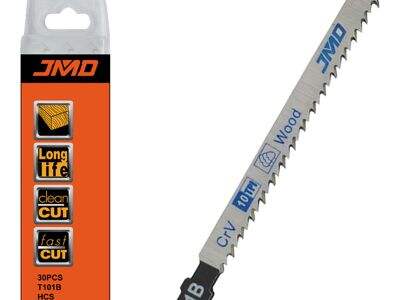Å gjøre nøyaktige skjæringer kan være vanskelig og kreve litt øvelse, men med riktige verktøy og teknikker kan du lære å lage renne og nøyaktige skilt. Den svingende savbladen er et av disse verktøyene som får god akseptans blant folk som skjærer gjennom ulike materialer. I denne artikkelen vil vi forklare betydningen av svingning for å gjøre jevne skjæringer, de mange fordeler med å bruke en svingende savblad, og hvordan disse bladene fungerer for å redusere svingninger for enda mer jevne skjæringer.
Ønsker du svingning for glatte skjæringer?
Svingning er et spesialuttale som betyr at savbladen går frem og tilbake når den skjærer. Denne trykk-og-pull-bevegelsen skyldes hvordan bladet er formet og hvordan saven opererer sammen med det. Svingende blader klarer å skjære gjennom materialer som tre eller metall mer jevnt og nøyaktig enn om de bare roterte i en sirkel. Denne frem-og-tilbake-bevegelsen gir deg større kontroll ved skjæring, noe som resulterer i renere skjæringer og mindre materialeavfall. Så det er svingningen som gjør at dine skjæringer ser pene og ordentlige ut.
Fordeler med en svingende sawblad
Sirkelsavblader har den fordelen at de kan skjære gjennom en rekke forskjellige materialer enkelt. Disse bladene er laget for å brukes på en bred vifte av materialer, inkludert hardtre, softtre, plast og metall. Denne fleksibiliteten gjør at sirkelsavblader blir utrolig nyttige verktøy som kan hjelpe deg i mange ulike skjæringsoppgaver. Sirkelsavbladet kan være et fremragende valg, uansett om ditt prosjekt krever tre, metall eller plast.
En ytterligere fordel ved sirkelsavblader er evnen til å skjære på en mer detaljert og kompleks måte. Fordi bladet beveger seg fram og tilbake i stedet for å dreie i klokkenes retning, kan det lage mer nøyaktige, detaljrikke skjæringer enn tradisjonelle savblader kan. Dette gjør også sirkelsav Savblade for håndsav ideelt for trearbeidere, metallarbeidere og andre håndverkere som trenger ekstremt presise skjæringer. Disse bladene anbefales sterkest når du må lage design eller former etc. hvor finere detaljer er nødvendige.
Hvorfor slår sirkelsågblader med vibrasjon av vibrasjonen?
En av de største hindringer for nøyaktig skjæring er vibrering. Rystelser gjør at bladen rister, og ustabilitet fører til ulike og uakkurate skjæringer. Du ønsker ikke dette når du prøver å lage et vakrt prosjekt. Nå, mange vibrerende såg. De tenderer til å opprette mye vibrasjon, noe som gjør det vanskelig å få en nøyaktig skjæring.
Det er laget på den måten, og sågen selv fungerer slik for å redusere vibrering. I forhold til standard saw blade , er kerfen (skjæringsbredden) av sirkelsågblader relativt smal. Å ha en mindre kerf betyr at mindre materiale må fjernes, hvilket betyr at vibrasjonene forårsaket av skjæringen også blir redusert. Det betyr at du kan fokusere på arbeidet ditt uten å bekymre deg for mye over at bladen beveger seg rundt.
Svingende savner har vanligvis også en spesiell funksjon som reduserer eller demper vibrationer ennå mer. Den hjelper til å begrense bevegelsen på blaaden, noe som gjør at det blir smoothere og mer nøyaktige klipp. Reduserte vibrationer betyr mindre bekymring for hvordan dine klipp kommer til å bli, med tillit til at klippene vil være rette og rene.
Hvilken svingende savblygger bør du velge?
Her er ting å ta hensyn til når du velger akkurat den riktige svingende savblyggen for dine behov. Først, tenk på hvilket materiale du skal skjære. Ettersom ulike materialer krever ulike blyggar, er det viktig at når du velger blygg, sørger du for at den passer til dine skjæringsbehov.
Deretter, overvei størrelsen på blyggen. Svingende Sirkelsagblad kommer i mange forskjellige størrelser, og å velge en som passer godt til din så er avgjørende. Størrelsen på bladet vil påvirke ytelsen til sawen, og et for stort eller for lite så kunne være usikkert (selv om det skjærer godt). Husk å alltid velge et blad som passer til typen og størrelsen på din så, samt materialet du skjærer.
Til slutt, sjekk tannmønsteret på bladet. Forskjellige typer av snitt blir akkommodert av forskjellige mønstre av tenn. For eksempel, noen blader vil hjelpe deg med å lage rette snitt mens andre vil hjelpe deg med å snitte kurver eller intrikate former. Sørg for at du velger et passende tannmønster for dine behov for å oppnå beste resultat.

 EN
EN
 AR
AR
 BG
BG
 HR
HR
 CS
CS
 DA
DA
 NL
NL
 FI
FI
 FR
FR
 DE
DE
 EL
EL
 IT
IT
 JA
JA
 NO
NO
 PL
PL
 PT
PT
 RO
RO
 RU
RU
 ES
ES
 SV
SV
 LV
LV
 LT
LT
 SR
SR
 SK
SK
 SL
SL
 UK
UK
 ET
ET
 HU
HU
 TR
TR
 FA
FA
 GA
GA
 CY
CY
 BE
BE
 IS
IS
 HY
HY
 AZ
AZ
 KA
KA
 LA
LA
 MY
MY
 XH
XH

